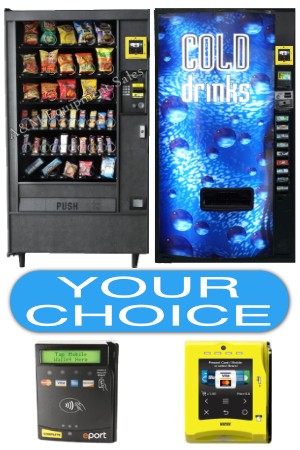Vending operation techniques If you have not read part one of this series: Are you “in” the vending business?, I suggest you do so! These articles are a comprehensive overview of the vending business. Success in business (or in life), is the compilation of many small activities, each of which, done properly, seems to be insignificant. Your small activities in the Vending Business are the basis for all profits that you may or may not have. Mind your pennies and the dollars will follow!
Vending Operation Techniques This article is about foundation building, getting the basics, creating a system that is functional and profitable and will build long term success. I start with a broad analysis. Have you ever looked at your operation objectively? Ever stepped back and dissected every function of your business, challenged you assumptions about the business? This is where I start!
Vending Operation Techniques has many components, is a dynamic distribution system, and can be as complicated or as simple as you would like it to be. I will put forth a few tips that might make you more efficient and more profitable.
Product Acquisition
Let’s face it, without product; you don’t have a vending business!
How do you get product? Do you go to warehouse clubs, order from manufacturers, third party suppliers, purchase through co-operatives, and other methods? Each of these methods has advantages and disadvantages, and one must stay focused on profitability when purchasing product.
With this in mind, do you purchase from the lowest priced supplier, is cost your only consideration? This is where proper analysis is critical. If you can purchase commodity type products (Coke, Frito Lay, Pepsi, and Hershey’s) at a lower price, doesn’t it make sense to purchase from that supplier? The question is not as obvious as it seems.
Have you ever factored in your acquisition costs? What’s an acquisition cost? An acquisition cost is the total cost of purchasing product including labor, interest, referrals, scheduling, availability, and all other factors that might affect your ability to get product.
Scenario
Vendor A buys from warehouse clubs. He goes to the club everyday and purchases product, he pays cash and uses the club as his warehouse. The club opens at 7:30 AM and closes at 9PM. The pricing is consistently low. He can purchase in relatively small quantities. He spends the first hour of his day in the club (they even give him a free cup of coffee and a pastry).
Vendor A analysis: vendor A’s acquisition cost seems to be low, he purchases at a low price, doesn’t have to inventory anything or maintain a where house. While these are valid points for Vending Business hobbyists, they do not include the real cost of acquisition. First, what is his labor worth? He spends 1 hour a day, 5 hours a week, 250 hours a year walking through picking product. At $10 per hour, it costs him $2500 per year in acquisition cost. But this is only part of the cost, what if he spent the first hour filling machines, at $100 gross, $50 net (if you’re not picking up $100 per hour and netting $50, you need to reschedule and raise prices, more later). So, now his hourly rate goes from $10 an hour to $40 per hour ($50 net – $10 hourly). $40 per day, $200 per week, $10,000 per year, assuming only one hour in the club; this equates to nearly $1000 per month in net profit! Would you like an account that does an extra $1000 per month?
This does not take into account other factors that can influence your business. Warehouse clubs have limited inventory in regards to selection. What you see, is what you get. From a marketing perspective, vend only products that are distributed through non warehouse lines differentiate your company from the part timers.
Product dating is also an issue; product oftentimes has “short” dates. Many warehouse clubs track the sales of their vending items and ship the soon to be out of date items to the clubs that sell the most of those items (and you would too!). This can lead to a mismatching of dates that require more time to rearrange your machines by date.
While these are not the only factors, they are significant if you examine your procurement procedures
Trucks
If you are in the vending business, you are in the trucking business. Most states require that you abide by the commercial truck laws of the state you do business in. Check out your local department of transportation to determine what your needs are.
Selecting the right truck and the layout of that truck is a determining factor in the efficiency of your operation. Determine your current needs, estimate your future needs, are you “specing” a proper truck size for your operation.
Factors to consider when choosing a truck
- Gross weight: How much do you plan to carry? Most vending operators move a large volume of product, but not much weight. Drinks are the determining factor. How many cases are you going to carry? Determine the maximum load to operate efficiently; determine the weight by total gallons times 8 pounds. Then add the weight of the truck chassis and the body, and add 500 pounds. This is the Gross Vehicle Weight Rating (GVWR) you need. Properly weighted trucks will break down less frequently, and do not expose your company to DOT tickets.
- Size and type of body: truck bodies come in many configurations, which do you choose? Most operators use box van bodies, but some use beverage bodies or specialized bodies specifically designed for vending operators. The length of your truck body is determined by how comfortable your drivers will be with certain lengths, amount of product that can physically be put in the cargo area, the amount of loading time required, warehouse facilities, expected dollar volumes, and so forth. A truck body that is too small requires constant reloading decreasing the amount of time a driver can spend filling machines. A truck body that is too big is difficult to drive & park, and dictates tracking product freshness and rotation. The height of a truck body also is in play, taller bodies allow greater capacities of lightweight voluminous product (chips, mostly air), but, concerns are driver height (can’t reach product on upper shelves), underpass restrictions, and wind conditions.
- Height from ground: do you work at street level or at dock level? Low profile trucks are better if you work primarily at street level. The amount of energy a driver expends getting in and out of a high profile truck could be turned into another stop! At dock level, the ability to roll product out in one motion also translates into an additional stop.
- Body equipment and layout: how do you equip your truck body, do you use adjustable shelves, coolers, drink racks, plastic bins? How do you arrange these items? A note on layout, we always arranged our products in the truck in the same order as the planogram (more later) of the machine. A driver moves in a predictable motion, with less energy and more efficiency if the product mimics his machines, he moves linearly instead of back and forth, and has less thinking to do (where is such and such). Benefits include more accurate pulling of product, faster “pick” lists, easier to track inventory of truck, consistency between vehicle (standardization). Our trucks were arranged exactly the same way, if a driver needed to swap vehicles, he noticed little difference (mostly cleanliness).
Vending Operation Techniques are concerns in which you can generate more profits by increasing your efficiency and effectiveness.



